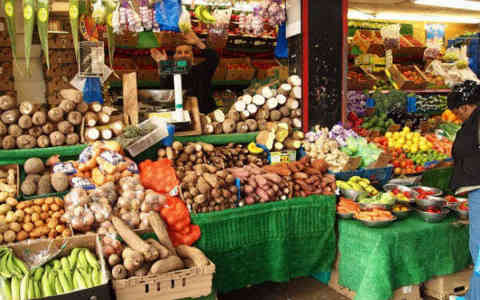15 best methods for preventing food wastage now
- Advertisement -
The 15 Easy Methods For Preventing Food Wastage you should know Now
Approximately 14% of food produced is lost between harvest and retail, according to studies.
Furthermore, significant amounts of food are wasted at both the retail and consumer levels.
- Advertisement -
Food loss is the amount of food lost from harvest to but not including the retail level, whereas food waste is the amount of food wasted at the consumer or retail level.
Data has it that food waste accounts for approximately 17% of total global food production, with households accounting for 11%, food service accounting for 5%, and retail accounting for 2%.
Food waste accounts for 38% of the energy consumed by the global food system.
- Advertisement -
The Food and Agriculture Organization of the United Nations (FAO) laments that food loss and waste put additional strain on natural resources and harm the environment.
Pay Attention To How to apply for INEC Adhoc staff recruitment pres.inecnigeria.org
The body explains that wasting food means wasting the labour, effort, investment, and precious resources used in its production, such as water, seeds, and feed, not to mention the resources used in transporting and processing it.
- Advertisement -
By increasing greenhouse gas emissions, food waste contributes to climate change.
The United Nations has issued the following 15 recommendations to reduce food waste and loss:
- Adopt a more sustainable and healthy diet
While life is busy and preparing nutritious meals can be challenging, healthy meals do not have to be difficult.
The internet is full of quick, healthy recipes that you can share with your family and friends.
-
Purchase only what you require.
Prepare your meals in advance. Create and adhere to a shopping list, and avoid impulse purchases.
- Advertisement -
Not only will you reduce food waste, but you will also save money!
-
Select unattractive fruits and vegetables
Food should not be judged solely on the basis of its appearance! Fruits and vegetables that are unusually shaped or bruised are frequently discarded because they do not meet arbitrary cosmetic standards.
Not to worry – they taste identical! Smoothies, juices, and desserts can all be made with mature fruit.
Reorganize your cupboard or refrigerator by storing older products in the front and new products in the back.
Refrigerate open food in airtight containers and seal packets to prevent insects from entering.
Recognise food labelling
There is a significant distinction between “best before” and “use-by” dates. Occasionally, food is safe to eat after the “best before” date, but the “use-by” date indicates when it is no longer safe to eat.
Food labels should be scrutinised for unhealthy ingredients such as trans fats and preservatives, and foods with added sugar or salt should be avoided.
15 easy methods for preventing food wastage now
Begin modestly
At home, serve yourself smaller portions or share large dishes at restaurants.
-
Admire your leftovers.
If you find that you are unable to consume everything that you have prepared, you can either put it in the freezer for later use or use it as a component of another meal.
Both buying fruits and vegetables that aren’t particularly appetising and finding new uses for food that’s been left over are two effective ways to cut down on food loss and waste.
- Use your Waste food
Compost your food scraps rather than throwing them away.
This way, you’re replenishing the soil with nutrients and lowering your carbon footprint.
-
Food should be respected.
Food is what brings us all together. Learn about the manufacturing process to reconnect with food.
Read about your farmers to learn about food production and get to know them.
Help local food producers
Buying local produce supports local family farmers and small businesses.
You also help to reduce pollution by shortening truck and other vehicle delivery distances.
Maintain fish population viability
Consume abundant fish species like mackerel or herring instead of overfished species like cod or tuna.
Buy fish that has been caught or farmed in a sustainable manner, such as eco-labeled or certified fish.
Furthermore, food worth millions of dollars rots in Niger.
Water conservation
We cannot produce food without water! While farmers must use less water to grow food, reducing food waste also conserves the water resources used to grow it.
Repairing leaks and turning off the water while brushing your teeth are two other ways to save water!
-
Maintain the cleanliness of our soils and water
Certain types of household waste are potentially hazardous and should never be disposed of in a regular trash can.
Batteries, paints, mobile phones, medicine, chemicals, fertilisers, tyres, and ink cartridges, among other things, can seep into our soils and water supplies, wreaking havoc on the natural resources used to grow our food.
Consume more pulses and vegetables
Consider eating a meal based on pulses or ‘ancient’ grains such as quinoa once a week.
Recommended for you
- 8 Reasons Why You Should Consume Bananas & Groundnuts Regularly
- 3 Major Benefits Of Tiger Nuts
- 10 Health Benefits Of Sugarcane Juice Now. So Amazing
- 15 easy methods for preventing food wastage now
- Sharing is being kind.
Donate food that would have been thrown away.
For instance, apps can connect neighbours and local businesses, allowing surplus food to be shared rather than thrown away.
Thanks for reading 15 Easy Methods For Preventing Food Wastage Now
- Advertisement -


